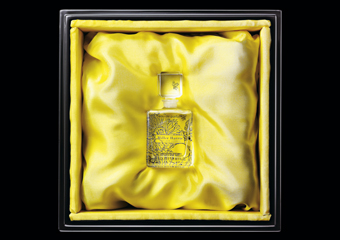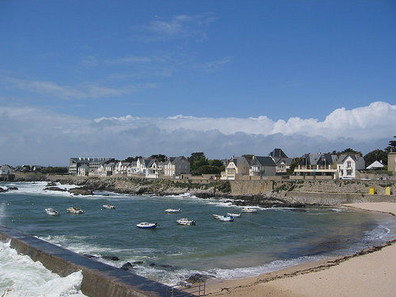Fleurs de Sel by Miller Harris {Perfume Review & Musings} {New Perfume}

Fleurs de Sel (Flowers of Salt, from "fleur de sel", "the best part of the salt") by Miller Harris is the latest creation by Lyn Harris. It is part of the Nouvelle Edition collection of more "unique and exclusive fragrances" from the house. We are told that it was inspired by a village in Brittany called Batz-Sur-Mer where the perfumer owns a vacation home and has spent some of the happiest moments in her life.
The poetic title for the perfume, Fleurs de Sel, invited some daydreaming about wild flowers growing in an unruly fashion by the salt marshes of a little corner in Brittany. In reality, the scent surprises in two senses. First, it seems closer in spirit to two recent creations by Chanel, namely 31, Rue Cambon and No 18, than to a familiar haunt by the sea. And interestingly enough, Miller Harris specifies that “This fragrance was created and finalised in Batz sur Mer, Summer 2006”, in case we had any doubts about the originality of the composition and its use of the painting-in-the-field Impressionistic technique. Second, the scent is closer to a warm oriental than to a marine, airy scent, an effect that is actually advertised by the house itself as it describes it as "deeply sensual and earthy". The interpretation of a northerly remote sea-side village is therefore less than literal. Again, if one expected a realistic rendition of a bucolic spot in wind-battered Brittany, one will not find it. It seems rather that Fleurs de Sel is trendy and strongly derivative and inscribes itself in the neo-chypre movement, the one illustrated recently by Serge Lutens Chypre Rouge, but even more closely and recently by Jacques Polge for Chanel. A common source of supply might explain the similarities with the latter's works......
Polge had explained that to create his new chypre he had made a substitutive use of patchouli to replace oakmoss, which is now banned as a perfumery raw material. We also learned that to create this new kind of chypre he had recourse to a new iris-pepper accord (see our post on 31, Rue Cambon).
The general impression one derives from the scent is more a sense of it having been made piecemeal, due to the perception of perfume accords that are like "perfume quotes" of fragrances that are too fresh in our memories to be forgotten or recalled only subliminally. Even more so, one fails to experience a sense of harmony between the different parts and transitions of the scent (not enough transitions).
Fleurs de Sel starts with a strong aromatic herbal impression of pungent herbs in the top notes - red thyme, rosemary, and clary sage - soon followed by a warm impression of sweet amber, vanilla, and “oakmoss”. It is at this point that it is very much reminiscent of 31, Rue Cambon. The development is fairly linear or rather non-dramatic for in the end there is a marked contrast between the oriental warmth of the beginning and the more luminous, aromatic chypre-like impression toward the end. In between, the scent develops an abstract powdery and creamy floral bouquet where a clove note appears to spice up the softness of the iris nobilis, narcisse flowers, and rose. The ambrette seed is quite pervasive coloring the perfume with its boozy overtones, inviting in a second stage to an irresistible comparison with the iris-ambrette seed accord in Chanel No18. There are dry white pale yellow alcohol facets that seem to have had salty vetiver steeped in them, but the salt impression apart from that hint is not very present, to the point where one wonders if it is more imagination suggested by the name of the scent than it is actual perception, except that one seems to taste some salt in one's mouth more so than smell it.
The dry-down is extremely discreet to the point of faintness although it offers a pleasant, subtle very low-key airy and luminous skin leather chypre impression. The subtlety at this point is reminiscent of Coeur d'Eté. The bottom note offers soft beach-y tones. Longevity for the eau de parfum concentration, which I am reviewing is better on the blotter than on the skin, but seems there also quite average.
Perhaps one could see Fleurs de Sel as a more affordable version of both 31, Rue Cambon and No 18, especially since many people like to layer the new Chanels. The added twist is an aromatic impression that might be the little piece of Batz-Sur-Mer yet preserved in a local perfume created with international raw materials.
Notes are " Earthy top notes of red thyme oil, rosemary and clary sage are bound with wild flowers of iris nobilis, narcisse flowers, rose and a hint of ambrette seed, finally blending them on a base of woods, vetiver grass and moss with a note of leather."
The eau de parfum retails for 95 Pounds and is available on the Miller Harris website.
Scents we prefer from Miller Harris are Coeur d'Eté and L'Air de Rien.











Interesting analysis, and one that makes me want to go and sniff by myself - I quite love 31 rue Cambon and own (but have given away to BF) Chypre Rouge. The idea of too-recent "perfume quotes" is particularly interesting. I'm seeing this trend in a lot of niches: something that's "inachevé" and unbalanced. Laziness or lack of mastery? Qui sait?
I realize I needed to be clearer concerning Chypre Rouge. I don't think it smells at all like Chypre Rouge (like 31, yes), but 31, FdS and CR are all part, for me at least, of this same movement of recreation of chypres. There are classical trends like for Soir de Sisley, classical-modern/hybrid like for Perles de Lalique, definitely "new" with Chypre Rouge, and maybe neo-classical with 31 Rue Cambon. Except for Soir de Lune, I would say that the others listed here I think of as "neo-chypres" or "new chypres". In part, this must be a push due to the challenge of doing without classical oakmoss.
Yes, once one accepts the idea that perfumery is derivative than one can modulate appreciations of the degree to which it is so. In this case, I think "strongly derivate" with too-recognizable "perfume quotes" because not enough time has elapsed in-between the scents. Since perfumes have that complex relationship with time, it seems thus that they become less subtle creations. If FdS had been created in 20 years, it would have a different meaning.
I think that more information is needed regarding sources of supply, bases that are pre-made, molecules that are pushed by laboratories, etc to have a better sense of the autonomy of the perfumer.
Perhaps naïveté and lack of time. Laziness and lack of mastery could also defnitely be considered.
Given the secretiveness of the business, I doubt any information will be forthcoming about sources of supplies, bases and new molecules... Barring access to a spectrometer or a bloodhound nose. I wish I knew more about it too. It seems important to understand the artistry (or lack thereof) of perfumery.
Isn't this fascinating..
I split a bottle of this w/ a soulmate [bless her !]-
Wore it all day yesterday.
I found it to undergo a lot of changes on my skin, and it brought out a good deal of vetiver [that's nice for me- because I love vetiver]...
It had a fairly decent longevity.
I liked it more than I expected to...
Go figure.
Chacun a son nez, je suppose !
Be well, you pretty ones...
Isn't all scent derivative by definition? This has been my favourite for the last two years. As a male user, I have always assumed it to be rather more masculine than feminine, but who cares when you smell this good? Sadly, it retails for £120 a bottle, not £95, but since it has immense longevity (especially on clothing) the price should be considered acceptable.